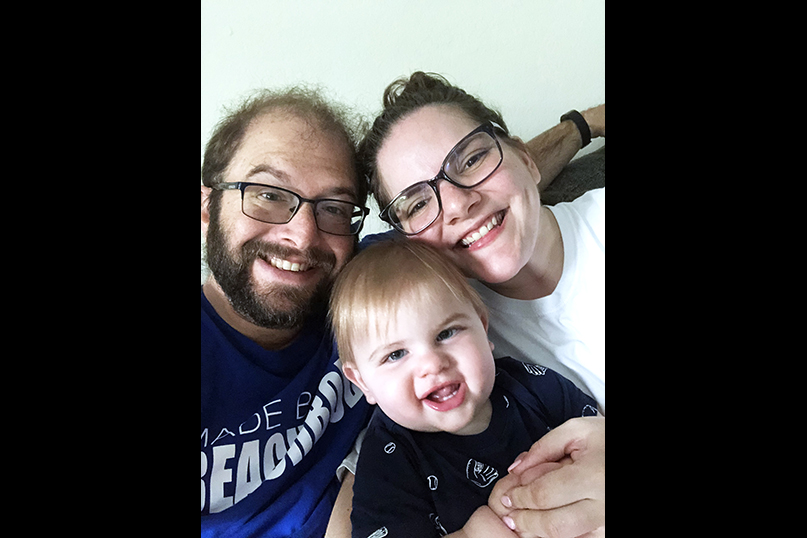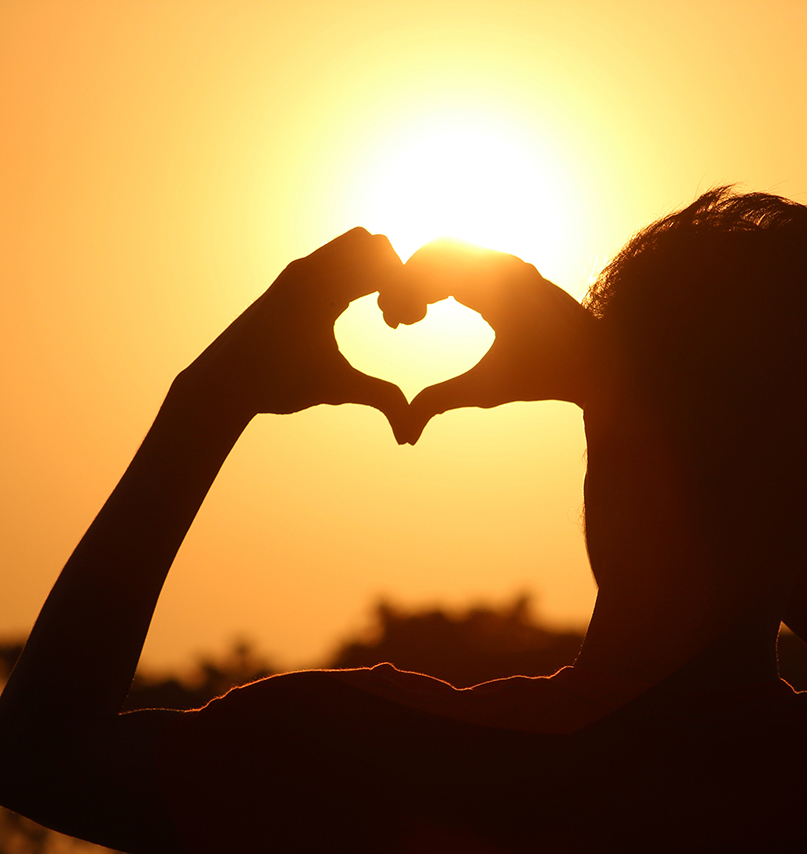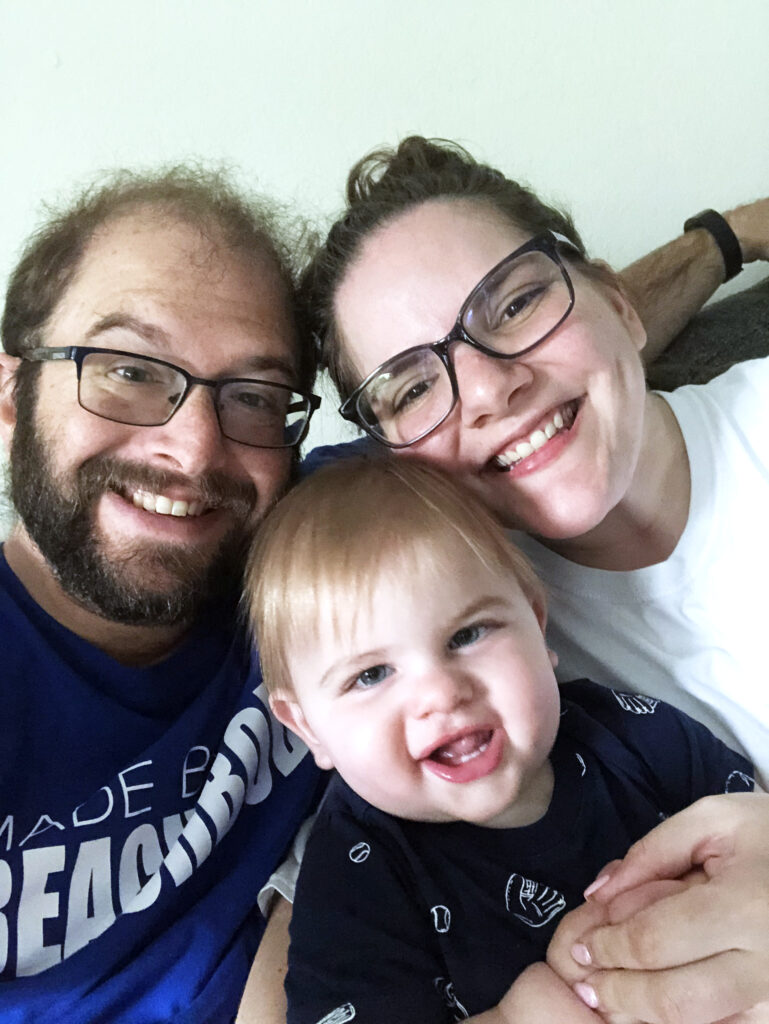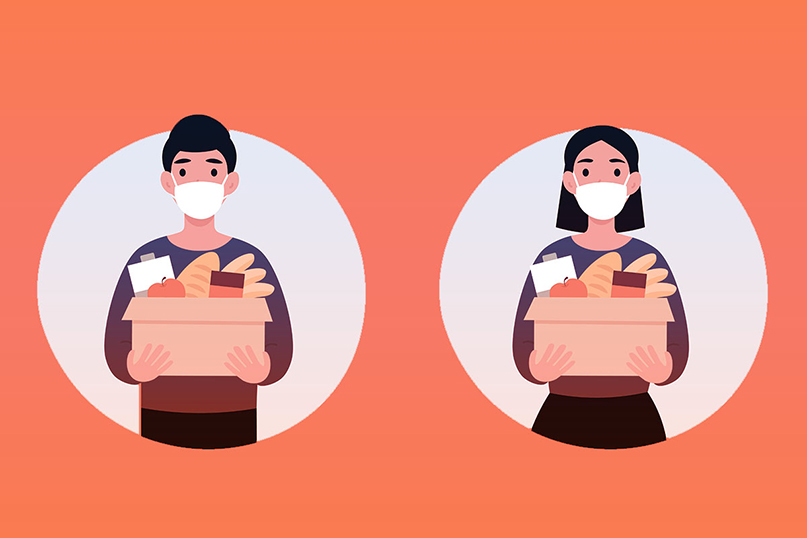

In this season of COVID, the act of giving tzedakah has taken on an elevated sense of urgency. Simply put, out of jobs and low on hope, many people are now relying on the help and good will of those more fortunate to survive. Literally.
Everyone has something to give. Cash is good. But so is giving of oneself; giving of one’s time and energy, efforts and expertise like cooking a meal for an elderly neighbor, visiting someone who is ill, volunteering at a food bank or shelter…and so on.
In the Jewish tradition we are taught that even a poor person who subsists on the charity of others is compelled to perform acts of charity. Because regardless of who we are, how we live or what we do, each of us has something to contribute to insure the welfare of others.
And so, this holiday season and all year round, give in any way you can. Give generously…give of yourself.
For one New Jersey man, charitable giving can be a life-saving experience
By Stacey Dresner
Giving can mean many things to many people.
It can mean donor-advised funds or bequests made by the wealthy to organizations and institutions they support.
Or taking part in Giving Tuesday, held on the Tuesday after Thanksgiving when corporations and consumers give hundreds of millions of dollars worldwide to non-profits like their local Jewish Community Centers and Jewish Family Services.
Giving can also mean volunteering in person for local organizations or organizing local fundraisers.

For Jonathan Newman of Wayne, New Jersey, giving – in the form of organ donation – could mean saving his life.
Newman, 38, has polycystic kidney disease (PKD), a genetic disorder that took the lives of both his grandmother and great-grandmother. In brief, Newman needs a new kidney – and he and his family are working hard to find an altruistic donor who can help save his life.
PKD, according to the Mayo Clinic, is “an inherited disorder in which clusters of cysts develop primarily within your kidneys, causing your kidneys to enlarge and lose function over time. Cysts are noncancerous round sacs containing fluid. The cysts vary in size, and they can grow very large. Having many cysts or large cysts can damage your kidneys.”
Since PKD is a genetic problem, and not an illness like diabetes, a donated kidney will not be attacked, and is expected to last many years, if not the patient’s full lifetime.
Newman is currently on three waiting lists for a new kidney, at Penn Hospital, the hospital of the University of Pennsylvania; Yale-New Haven Hospital and Saint Barnabas Hospital in Livingston, New Jersey.
He is also on matchingdonors.com., a non-profit website that links those seeking organs with potential donors.
It is expected that once Jonathan receives a new kidney, he will be able to lead a normal life.
Jonathan Newman and his wife Stacie spoke to the Jewish Ledger on Dec. 9, about Jonathan’s disease, their healthy 13-month old son, who is PKD-free, and their quest for a kidney donor.
“What people don’t realize is that you are giving something that is going to help our young family,” Stacie explained. “Yes, it’s a lot of work to get tested and yes, obviously it’s a surgery, but it’s not as invasive of a surgery as it used to be… And you are giving somebody the chance of living a more healthy and fulfilling life that they would have otherwise…At the end of the day, you are helping a family – giving them a gift.”
A gift that lasts a lifetime
Jonathan Newman’s mother, Lois Newman, received a kidney transplant from a live donor found on matchingdonors.com at Yale University Hospital six years ago.
“Her mother and her grandmother both died of it. Who knows if anybody had it before that,” said Edward Newman, Jonathan’s father. “Lois has always had polycystic kidney disease since she was a kid. It didn’t manifest itself – the symptoms – until she was 60.”
Forty years ago when Lois and Edward wanted to have children, they were told they should adopt to avoid having a child with PKD.
“In our minds we figured, it’s been this way so long, by the time our child is old enough to have a problem there will be a cure for this,” Edward said. “But that didn’t happen.”
Still, both Lois and her brother, who had a kidney transplant 25 years ago, now lead healthy, PKD-free lives with their new kidneys.
“There’s no cure for it as we speak,” Edward explained. “This is a genetic disease, so the new kidney can’t be attacked by PKD. [And so], for Lois and her brother, this will last a lifetime.”
While PKD is a genetic disease, it is not one that attacks Jews specifically. Potential donors to Lois and Edward’s son Jonathan do not have to be Jewish.
“Anybody can be a donor, you just have to be a compatible blood type and tissue type,” Edward said.
Like his mother, Jonathan said that he always knew he was likely to have PKD, but he had no symptoms until he was 18.
“I had kidney stones, and they found out I had polycystic kidneys,” he recalled.
For years Jonathan has seen a nephrologist at Yale every year – now every six months – to keep an eye on the disease’s progression.
But PKD hasn’t just affected Jonathan in terms of his own health.
“We wanted to start a family and we didn’t want our baby to have my disease,” he said.
The couple ended up not being able to get pregnant because PKD affected Jonathan’s sperm count. His nephrologist suggested the couple see a fertility specialist.
While there is no real cure for PKD, as Jonathan’s parents had once hoped, there have been amazing advances in reproductive medicine and genetic testing, including the personalized test for the PKD gene Jonathan and Stacie underwent, created by Cooper Genomics.
“The specific test we had was under the category of PGTM, pre-implantation genetic testing for monogenic/single gene defects,” Stacie explained. “The test took about eight weeks to create once we submitted blood work and DNA samples. Once ready, we began the IVF cycle.”
Through this testing, an embryo without PKD was produced.
“That embryo is now in the other room asleep in his crib,” Stacie joked.
In the meantime, shortly after Mason’s birth, one of Jonathan’s test numbers came back low and the nephrologist suggested he get on some kidney donor lists.
“Some lists take five days, some take 10 years,” Stacie said. “He’s hooked up with Matching Donors, which is how his mom got her transplant. I don’t know how many people even know organizations like Matching Donor’s exist, but maybe if they did they would be able to get more information about how organ donation works.”
One of their goals is for Jonathan to have a transplant before he has to go through dialysis.
“My grandmother was on dialysis for nine months; my grandmother died under dialysis. I want to avoid that,” he said.
For now, he is taking Jynarque, a medication that slows down the kidney function in adults with PKD, and by doing that also slows down the progression of the disease. He says he is doing well on the medication, “Except for the fact that I’m peeing like a racehorse and drink a ton of water!”
Every three months he must see the nephrologist at Yale and has blood tests monthly at all three of the hospitals in which he is on waiting lists.
And now, Covid has thrown in a curveball.
“Right now because of the virus, not a lot of people are donating, understandably so,” Stacie said.
But Jonathan remains optimistic about his chances of finding a donor and living a long, healthy life.
“I’m living a healthy lifestyle, exercising and eating the right foods. It is what it is…I’m scared, but I don’t tell people. I’m just happy that Mason is healthy. That is a huge relief,” said Jonathan.
The couple was forward to celebrating Mason’s first real Chanukah on the following evening.
“We’re excited to see him tomorrow with the menorah,” Stacie said. “We’re excited to see it through his eyes.”
For further information, please contact Jonathan Newman’s father, Edward Newman at enewman591@aol.com or (201) 265-2939.
We need to step up our charitable giving during the pandemic – it’s the Jewish thing to do
By Yvette Alt Miller
(JTA/Kveller) It’s been decades since I ordered food at a McDonald’s. I’ve kept kosher since I was 18 and, outside of Israel, at least, Mickey D’s is decidedly treif.
Except recently, I found myself entering and ordering a decidedly nonkosher cheeseburger and fries.
To be clear, the food wasn’t for me. After months of sheltering in place in my suburban neighborhood, I could no longer put off a downtown appointment. So the other day I headed to Chicago’s central business district, making my first journey to the Loop since March. It felt like something out of a dystopian movie. The typical afternoon crowds had disappeared: There were no masses of people hurrying along the wide avenues; gone were the packs of tourists that stopped foot traffic as they gaped at the city’s skyscrapers. There was also hardly any litter – even the alleyways, usually full of detritus, were eerily clean.
Homeless people seemed to be the largest contingent I saw. On most corners I passed, there were several.
“Can you help me out?” one implored. Another asked for money, saying he was cold and wet and needed help. The amount of need felt so overwhelming that at first I rushed past them all, ignoring their pleas.
Then, just before I boarded a train that would take me back to the suburbs, I asked myself why I hadn’t helped anyone. After all, I had some cash on me: Why hadn’t I given any out? Just then, I was approached by a skinny man about my age who asked for help.
“Sure, I can help you,” I said as I reached for my wallet.
“I don’t want your money,” he responded. “Can you buy me a meal instead?”
“Of course,” I replied, trying to mask my shock as it occurred to me that as I almost rushed by, there was a human standing here hungry. I’d given plenty of money to beggars in my life, but nobody had ever asked me to buy them food directly. I asked him where he wanted to go, and he led me to a nearby McDonald’s, one of the few restaurants that was still open – another shocking aspect of Chicago’s newly quiet downtown.
My new acquaintance ordered a cheeseburger. Before I paid, I hesitated.
“Why didn’t he order dinner, too, for later?” I asked. He ordered Chicken McNuggets and some sides. I swiped my credit card: a total of $16 for providing a day’s worth of food.
“God bless you – you’re the only one who stopped,” he told me.
In a time of such enormous need, his words broke my heart. After all, the coronavirus pandemic has decimated the U.S. economy – as well as much of the world’s. A recent poll by the Pew Research Center found that about one-fourth of Americans have had trouble paying their bills over the past seven months. Demand at food banks has risen at an “extraordinary rate,” according to The New York Times, and up to 14% of American parents now say their children are not getting enough to eat.
“The number of families having difficulty affording food has exploded during COVID-19,” the nonpartisan Center on Budget Policy and Priorities recently noted.
Each week, a food pantry near my home offers drive-through food assistance. The line to receive these donated boxes of food is long and filled with later-model minivans. Just a few months ago, many of these people would never have imagined being in this position. But jobs have been eliminated, salaries have been cut and workers have been furloughed. Poverty and food insecurity aren’t always easy to spot – your neighbor, your child’s teacher, the parent serving on the PTA with you can all be suffering from food insecurity now.
I’d like to say that the American Jewish community has stepped up to help. And, in many ways, Jewish institutions have indeed pledged funds to alleviate the worst effects of the pandemic. In this unprecedented moment, it’s wonderful that many Jewish institutions are reimagining themselves and redoubling their efforts to help those in need.

But are we, as Jewish individuals and families, doing the same?
Judaism mandates giving charity: The Talmud goes into great detail about the many obligations we have to help others, declaring “Charity is equivalent to all the other mitzvot combined” (Talmud Bava Batra 9a). The Jewish mitzvah of “maaser kesafim” instructs us to donate a portion of our income to charity. Rabbis through the ages interpreted this to mean that we should donate at least a tenth of our income to charity.
For too many of us, however, performing this mitzvah feels like an impossible ideal rather than a tangible rule for life. I once heard a Jewish children’s song that described the Jewish mitzvah of tzedakah as “coins clinking in a can,” and I was so surprised: Jewish views of tzedakah are traditionally much more substantial – not just pocket change but enough money to materially help other people.
Perhaps now it’s finally time for us to have a difficult conversation about our attitudes to giving charity and to the poor. Over the years, I’ve heard some troubling comments reflecting a profound reluctance to help others. A friend once told me she didn’t donate her children’s castoffs to charity because she didn’t believe in helping people bear “children they can’t afford.” A 10-year-old student in one of my Sunday school classes was taken aback one day when we learned that the Jewish sage Maimonides taught that the highest form of charity was giving a poor person a job.
“But poor people don’t want to work,” she said, no doubt echoing what she’d heard at home. “That’s why they’re poor!”
Unsurprisingly, the reality is very different: A report in October from the U.S. Bureau of Labor Statistics found that the overwhelming majority of unemployed workers – 7.2 million – expressed hope of finding another job soon. That number was substantially higher than before the pandemic hit.
These attitudes have long been a problem, but today they’re a crisis in our country that we can’t ignore. In a world buffeted by recession and sudden destitution, we need to rediscover the central Jewish tenet of charity more than ever. When people can no longer feed themselves – when people are begging on street corners, wracked by hunger and asking for succor – we have no choice but to step up and help.
It’s time for us as a community to step up to the plate and, if we are in a position to help, we must increase our charitable giving. Whatever your current level of giving is, consider giving more. Reach out to your local synagogue, JCC or Jewish federation and ask what they’re doing to help people in your community. If you feel they’re not doing enough, urge them to do more, and consider volunteering to help spearhead new programs. Contribute to the emergency relief funds. Donate to established charities. And remember, too, that tzedakah isn’t always made up of money – if funds are tight, we can also help by volunteering our time and expertise.
A few weeks ago, if you had asked me whether there was more I could do to help, I might have said no. I already donate between 10% and 20% of our income to charity. Each week, before I light my Shabbat candles, I set aside money for tzedakah. I might have said I was maxed out – I certainly would never have thought I’d be paying an impromptu visit to McDonald’s. But there’s always more we can do, more we can give.
Judaism teaches that we are each here to fulfill a specific set of tasks that only we can perform and for which we’re given the precise, individual tools we require. Let this be our moment to shine. Let this pandemic be our time to step up and start helping our fellow men and women in their hours of need.
This article originally appeared in Kveller (kveller.com)








 Southern New England Jewish Ledger
Southern New England Jewish Ledger









